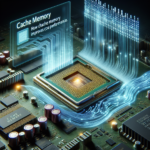The Relationship Between CPU and Network Performance

The Relationship Between CPU and Network Performance
In the digital age, the performance of computer systems is paramount for both personal and professional use. Two critical components that significantly impact overall system performance are the Central Processing Unit (CPU) and the network. Understanding the relationship between CPU and network performance is essential for optimizing system efficiency, reducing latency, and ensuring smooth operation of applications. This article delves into the intricate relationship between CPU and network performance, exploring how they interact, influence each other, and the best practices for optimizing both.
Understanding CPU Performance
What is a CPU?
The Central Processing Unit (CPU) is often referred to as the “brain” of the computer. It performs the majority of the processing inside a computer, executing instructions from programs and managing the flow of information through the system. The CPU’s performance is determined by several factors, including clock speed, core count, and architecture.
Factors Affecting CPU Performance
- Clock Speed: Measured in gigahertz (GHz), clock speed indicates how many cycles a CPU can perform per second. Higher clock speeds generally mean faster processing.
- Core Count: Modern CPUs have multiple cores, allowing them to perform multiple tasks simultaneously. More cores can significantly enhance performance, especially for multi-threaded applications.
- Architecture: The design and efficiency of a CPU’s architecture can impact its performance. Innovations in architecture can lead to better performance per watt and improved processing capabilities.
Understanding Network Performance
What is Network Performance?
Network performance refers to the speed, reliability, and efficiency of data transfer across a network. It is a critical factor in determining how quickly and effectively data can be transmitted between devices, servers, and other network components. Key metrics for network performance include bandwidth, latency, and throughput.
Factors Affecting Network Performance
- Bandwidth: The maximum rate at which data can be transferred over a network connection, typically measured in megabits per second (Mbps) or gigabits per second (Gbps).
- Latency: The time it takes for data to travel from the source to the destination, usually measured in milliseconds (ms). Lower latency means faster data transfer.
- Throughput: The actual rate at which data is successfully transferred over the network, taking into account factors like network congestion and packet loss.
The Interplay Between CPU and Network Performance
CPU’s Role in Network Performance
The CPU plays a crucial role in network performance by handling various tasks related to data processing and transmission. These tasks include:
- Packet Processing: The CPU processes network packets, which are units of data transmitted over a network. Efficient packet processing is essential for maintaining high network performance.
- Encryption and Decryption: The CPU handles encryption and decryption of data to ensure secure communication. This process can be CPU-intensive, especially for high volumes of data.
- Protocol Handling: The CPU manages network protocols, such as TCP/IP, which are essential for data transmission and communication between devices.
Network’s Impact on CPU Performance
Conversely, network performance can also impact CPU performance. Poor network performance can lead to increased CPU usage due to the following reasons:
- Retransmissions: High packet loss or network congestion can cause data retransmissions, increasing the CPU’s workload.
- Latency: High latency can lead to delays in data processing, causing the CPU to wait for data and potentially leading to inefficiencies.
- Interrupt Handling: Network interfaces generate interrupts to signal the CPU about incoming data. High network traffic can lead to frequent interrupts, increasing CPU load.
Optimizing CPU and Network Performance
Best Practices for Enhancing CPU Performance
To optimize CPU performance, consider the following best practices:
- Upgrade Hardware: Invest in modern CPUs with higher clock speeds, more cores, and advanced architectures.
- Efficient Software: Use software that is optimized for multi-core processing and efficient resource utilization.
- Regular Maintenance: Keep the system clean and free of malware, and ensure that software and drivers are up to date.
Best Practices for Enhancing Network Performance
To optimize network performance, consider the following best practices:
- Upgrade Network Infrastructure: Use high-speed network equipment, such as gigabit routers and switches, and ensure that cabling is of high quality.
- Optimize Network Configuration: Configure network settings to reduce latency and improve throughput, such as adjusting MTU size and enabling Quality of Service (QoS).
- Monitor Network Traffic: Use network monitoring tools to identify and address congestion, packet loss, and other performance issues.
Case Studies: Real-World Examples
Case Study 1: Data Centers
Data centers are a prime example of environments where CPU and network performance are closely intertwined. High-performance CPUs are essential for processing large volumes of data, while robust network infrastructure ensures fast and reliable data transfer. In data centers, optimizing both CPU and network performance is critical for maintaining service quality and minimizing downtime.
Case Study 2: Online Gaming
Online gaming is another area where the relationship between CPU and network performance is evident. Gamers require powerful CPUs to handle complex game physics and graphics, while low-latency, high-bandwidth networks are essential for real-time multiplayer interactions. Any lag in network performance can lead to a poor gaming experience, highlighting the need for balanced optimization of both components.
FAQ
How does CPU speed affect network performance?
CPU speed affects network performance by determining how quickly the CPU can process network-related tasks, such as packet processing, encryption, and protocol handling. A faster CPU can handle these tasks more efficiently, leading to improved network performance.
Can a slow network impact CPU performance?
Yes, a slow network can impact CPU performance. High latency, packet loss, and network congestion can increase the CPU’s workload due to retransmissions, interrupt handling, and waiting for data, leading to reduced overall system efficiency.
What are some tools for monitoring CPU and network performance?
There are several tools available for monitoring CPU and network performance, including:
- CPU Monitoring Tools: Task Manager (Windows), Activity Monitor (macOS), htop (Linux)
- Network Monitoring Tools: Wireshark, NetFlow Analyzer, SolarWinds Network Performance Monitor
How can I reduce CPU usage caused by network activity?
To reduce CPU usage caused by network activity, consider the following strategies:
- Optimize Network Configuration: Adjust settings to reduce latency and packet loss.
- Use Efficient Protocols: Implement protocols that minimize CPU overhead.
- Offload Tasks: Use hardware acceleration or dedicated network processors to offload network-related tasks from the CPU.
Conclusion
The relationship between CPU and network performance is complex and interdependent. Both components play crucial roles in determining the overall efficiency and responsiveness of a computer system. By understanding how they interact and influence each other, and by implementing best practices for optimization, it is possible to achieve significant improvements in system performance. Whether in data centers, online gaming, or everyday computing, balancing CPU and network performance is essential for ensuring a smooth and efficient user experience.




